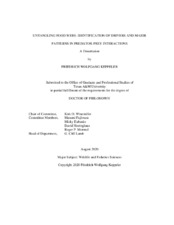| dc.contributor.advisor | Winemiller, Kirk O | |
| dc.creator | Keppeler, Friedrich Wolfgang | |
| dc.date.accessioned | 2021-02-22T16:00:21Z | |
| dc.date.available | 2022-08-01T06:51:38Z | |
| dc.date.created | 2020-08 | |
| dc.date.issued | 2020-07-16 | |
| dc.date.submitted | August 2020 | |
| dc.identifier.uri | https://hdl.handle.net/1969.1/192523 | |
| dc.description.abstract | Identification of the main factors (e.g., species traits, environmental conditions) underlying predator-prey interactions is an important step to reveal species organization within food webs, potentially improving our predictions and management of natural ecosystems. Using a large and detailed dataset of freshwater and estuarine fishes, I explored how body size and other functional traits of consumers are linked with their trophic position, trophic niche width, and food item size. I also explored the degree to which phylogenetic relatedness and morphological similarity predict similarity of consumer species in terms of diet and stable isotopic ratios (δ15N and δ13C), two common descriptors of the trophic niche. Functional traits were significantly associated with phylogeny, and both morphological traits and phylogeny were significantly associated with fish diets and isotopic ratios; however, functional traits were stronger predictors of dietary and isotopic ratios than phylogenetic relationships. I inferred that functionally relevant morphological traits of fish can be used to infer trophic niches for certain kinds of questions and analyses when trophic data are lacking. Trophic position– body size relationships were weak and only statistically significant for predatory fishes at the species level. Gut length was considered a better predictor of trophic position than body size. At the intraspecific level, trophic position – body size correlations varied from negative to positive depending on other functional traits (e.g., body depth, tooth shape, mouth width). Food item size and trophic niche width were all positively related to body size and negatively associated with gut length at the species level; mouth width was positively associated with food item size. Therefore, the incorporation of functional traits and their intermediate pathways is critical for understanding size-based trophic relationships of animal groups that encompass diverse feeding strategies. Given the diverse ecological strategies encompassed by fishes, organism trophic positions and food web patterns and processes cannot be inferred based solely on body size. Research that integrates multiple functional traits with trophic ecology will improve understanding and predictions about food web structure and dynamics. | en |
| dc.format.mimetype | application/pdf | |
| dc.language.iso | en | |
| dc.subject | food webs | en |
| dc.subject | functional traits | en |
| dc.subject | body size | en |
| dc.subject | trophic level | en |
| dc.subject | | en |
| dc.title | UNTANGLING FOOD WEBS: IDENTIFICATION OF DRIVERS AND MAJOR PATTERNS IN PREDATOR-PREY INTERACTIONS | en |
| dc.type | Thesis | en |
| thesis.degree.department | Wildlife and Fisheries Sciences | en |
| thesis.degree.discipline | Wildlife and Fisheries Sciences | en |
| thesis.degree.grantor | Texas A&M University | en |
| thesis.degree.name | Doctor of Philosophy | en |
| thesis.degree.level | Doctoral | en |
| dc.contributor.committeeMember | Fujiwara, Masami | |
| dc.contributor.committeeMember | Eubanks, Micky | |
| dc.contributor.committeeMember | Hoeinghaus, David | |
| dc.contributor.committeeMember | Mormul, Roger P | |
| dc.type.material | text | en |
| dc.date.updated | 2021-02-22T16:00:22Z | |
| local.embargo.terms | 2022-08-01 | |
| local.etdauthor.orcid | 0000-0002-5165-1298 | |


